Visiting Venice in winter can be a true delight. You’ve most likely ended up here because you’re considering a trip to the famous city in the winter and you’re wondering if it’s a good time to visit and about all the down sides of visiting when it’s cold and dark out. Well, lucky you. You’ve come to the right place!
Venice is one of the most popular tourist destinations on the entire planet. And for good reason – it’s simply stunning and a marvel of human ingenuity and engineering. But with popularity comes overcrowding.
But fear not, my friend. Because visiting Venice in winter allows you to take in its beauty and charm without being shoulder to shoulder with your fellow travelers. So let’s start with a quick rundown of Venice, then we will get into the top 5 reasons why you should consider visiting Venice in winter.
Note: this article contains affiliate links, which means that should you purchase something or get a quote through them I may make a small commission at no additional cost to you. This helps keep the site running with up to date information. I do not represent World Nomads, Booking.com, GetYourGuide, or discovercars.com. This is information only and not a recommendation to buy the product mentioned in this article.
The Top 5 Reasons to Visit Venice in Winter
Let’s get into it now. Here are the top 5 reasons why you should visit Venice in winter! For practical information about visiting Venice in winter, check out the second to last section on this page.
1) The crowds are bearable
The number one reason by far to visit Venice in winter is to avoid the crowds. It’s really far and beyond all the other reasons below. With about 5.5 million annual visitors, the city just barely ranks in the top 50 most visited cities in the world. But compared to places like London, New York, and Rome, Venice is tiny, with a population of barely 250,000 residents.
Now let’s consider that those 5.5 million visitors are going straight to the historical main islands that are separated from the more populated mainland by the Venetian lagoon. The part of Venice that tourists come to see has only about 55,000 residents and is barely 2 miles across.
Most visitors come in the warmer half of the year, so you can imagine just how crowded the streets and plazas can get in the summer. It might look a little like the photo below. Venice has becomes so crowded that the local authorities are still looking at ways to limit tourists on top of the 5 euro per day fee they installed for day-only visitors in 2024.
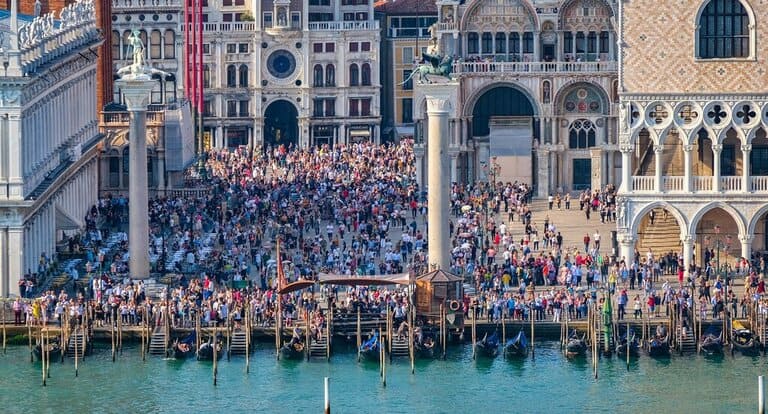
If being stuck in a massive crowd of people and waiting in queues of hours for museums and palaces doesn’t sound like your idea of fun, then winter in Venice is for you. There will still be some crowds here and there for the more popular attractions like Campanile di San Marco or Basilica di San Marco, but they will be manageable.
The walkways along the canals will not be crowded and most restaurants will be happy to seat you. If you want beautiful photos without having to edit out the crowds of people, winter is for you.
Just note that around Christmas, New Years, and February’s Carnival celebration, the crowds are likely to be more significant (especially for Carnival).
2) Few cruises stop at Venice in winter
Have you ever been somewhere beautiful that’s a major cruise port (like San Juan Puerto Rico perhaps?) and had a nice breakfast just to be overwhelmed with a massive crowd of people that seemingly came from nowhere and took over the city?
Cruises tend to do this, and Venice is a popular stop for many cruises (though the city has significantly reduced the number of cruise ships allowed to dock in recent years). Just about all of the cruises, however, run between March and October. So visiting in the winter relieves you of the extra crowds that come from the cruise ships.
3) Hotel prices are discounted
Since I’m sure you understand the concept of supply and demand, it should be no surprise that hotel prices in the winter are significantly less than summer prices.
Unlike many other popular tourist cities in Europe like Rome, London, or Paris, there really isn’t much of a local economy in central Venice outside of tourism. Very few people visit on business. This leads to a sharp decline in hotel prices once the crowds start to thin out towards the end of the year.
Often you can find hotels for half or even less the cost of the same room in the summer. This depends on the type of hotel though. If you’re looking for a discount at ultra-luxury places like the St. Regis or the JW Marriott, you’re going to be disappointed. But most 2-4 star hotels and some 5 star hotels will have significantly cheaper rates in the off-season.
4) Everything is still open
Whereas many Mediterranean holiday destinations really slow down in the winter, Venice stays alive. Hotels and restaurants don’t shut down for the season like most do in Santorini and Dubrovnik and many other places. Everything is still open in Venice, even if the hotels and restaurants are not filled to capacity.
5) The beauty of Venice is manmade
Ever been somewhere nice in the winter and your views and photos are sort of tainted by bare branches on trees and dead bushes? Well, in Venice you really don’t have to worry about that since the city is almost completely devoid of any vegetation. The beauty of Venice is completely man made (more on that later).
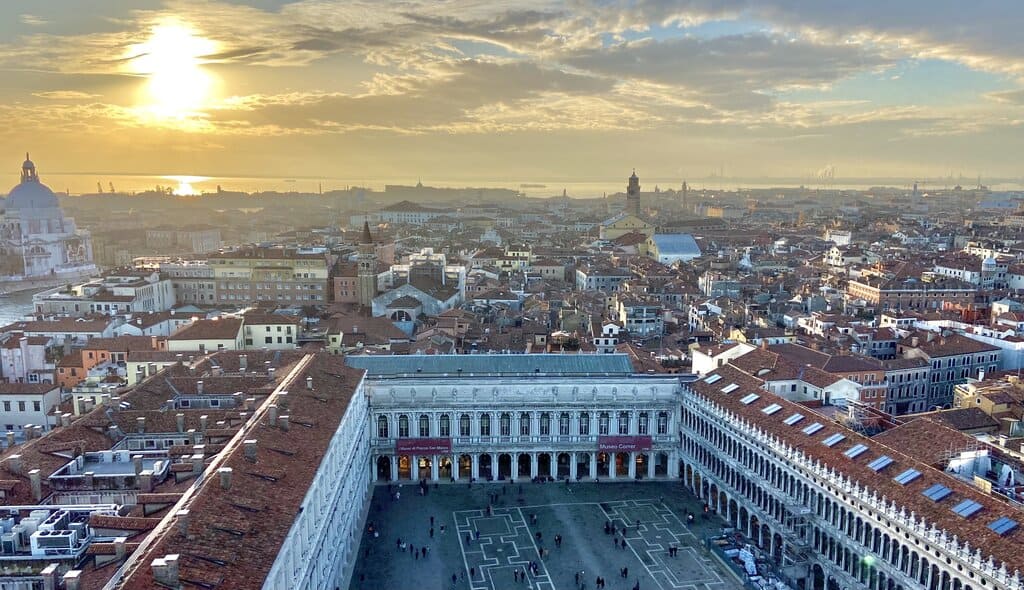
A beautiful photo of Venice at sunset will look the same whether it’s taken in August or January, so long as the sky is clear. If you look at the photos on this page, you can’t even tell that the photos were taken in late November (well, aside from the jacket I’m wearing). There are not a lot of places in central Europe that you can say that!
Looking for some off the beaten path European city destinations for a summer holiday? Then you might want to check out:
The Drawbacks of Venice in Winter
Now if all this sounds pretty great so far, just remember that it’s not all smooth sailing on a winter trip to Venice. The drawbacks of this time of year are solely weather-related. It will not be warm, and if you’re unlucky it might even be below freezing overnight.
It hardly ever snows in Venice so don’t expect to see the city as a winter wonderland. Snow happens, but it’s not common and usually limited accumulation. It’s also unlikely that the sky will be completely clear the entire time you’re there. It will most likely rain at some point. But the weather changes fast in Venice so a light rain could be clear blue sky in a matter of minutes.
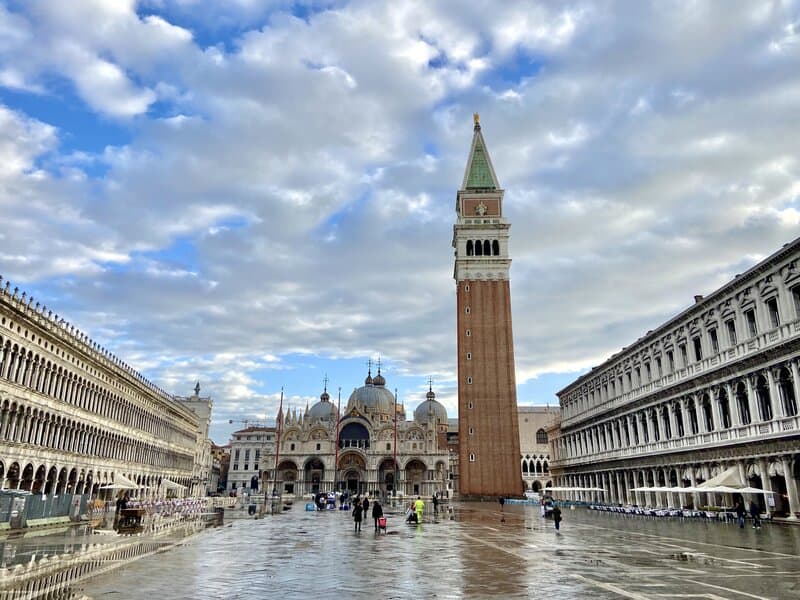
Winter temperatures
The temperatures in winter are one of the biggest drawbacks. If you have dreams of Venice that involve sitting out on a terrace in a summer dress, then this isn’t for you. But during the day if it’s sunny and a bit above average it can be warm enough to sit outside with only a light jacket. I ate lunch outside on both of my days in Venice in late November and was not cold at all.
The average highs and lows for Venice in winter are as follows:
- November: 56 F (13 C) high and 43 F (6 C) low
- December: 47 F (8 C) high and 34 F (1 C) low
- January: 46 F (8 C) high and 33 F (0.5 C) low
- February: 49 F (9 C) high and 34 F (1 C) low
- March: 56 F (13 C) high and 40 F (4.5 C) low
If this sounds fine to you then you won’t mind the winter temperatures in Venice!
Daylight hours
It goes without saying that your daylight hours are limited on a winter trip to Venice. March would be the ideal winter month to visit, as by March the days are back to about 11 hours long and the sun doesn’t set till 6:00 PM at the start of the month. As opposed to December when the days are less than 9 hours long and the sun sets at 4:30.
At the summer solstice the sunset is about 9:00, so you can judge for yourself how many photo ops you’ll miss on a short winter day. Fear not though, as Venice is stunning all lit up at night as well!
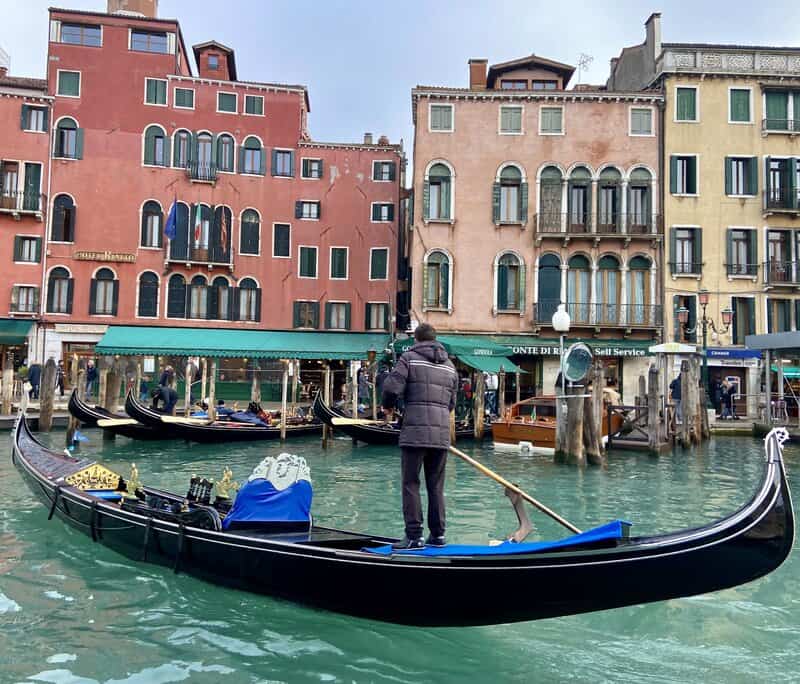
Flood season
You’ve probably seen photos and heard stories of large plazas in Venice completely under water. The city was built on a shallow lagoon over 1000 years ago and throughout its history has suffered catastrophic floods. The risk of flood is the highest between October and December.
Unlike floods caused by excessive rain or storm surge, the Venice floods are simply caused by rising tides. This means it happens every year, though the magnitude of the floods vary. And as sea waters rise globally, Venice has a serious risk of being swept away, as its elevation is just a few feet above sea level.
Luckily, as of 2020 a new flood protection system known as MOSE has been in place. A wonder of modern engineering, the new locks are able to prevent the damaging flooding that Venice is known for. The series of enormous flood barriers was built over the course of 40 years. But the wait seems to be worth it. Since it’s opening for 2020’s flood season, Venice is yet to flood.

The data looks promising so far and it seems you won’t have to worry about Venice flooding during your trip. But the system is relatively new and no one is sure if it’s 100% effective yet. So just keep in mind that there’s still a miniscule possibility that you’ll be treading through thigh-high water in Piazza San Marco.
Top Things to do in Winter in Venice
Let’s quickly go over some of the best things to do on your winter trip to Venice. This is not intended to be a full rundown of all the incredible things to do in Venice, but just a quick sample of some of the best things to do when you’re visiting during the colder months of the year.
Take a gondola ride
This is an obvious one. Winter or not, it’s Venice after all. Its cheesy and cliché, but just something you gotta do when visiting Venice.
Visit the Doge’s Palace
The Doge’s Palace is a grand palace on the lagoon that was the residence of the Doge of Venice, i.e. the supreme authority of the Republic of Venice. It was first built in 1340 and has had various extensions over the centuries. Entry is 30 euros, or 25 euros if you purchase more than a month in advance. It is highly recommended to purchase tickets online ahead of time, as it can get quite busy even in winter.

Take a long walk around the city
One thing that surprises many visitors about Venice is just how many canals and pedestrian streets there are. You can walk around Venice for hours and not see the same buildings twice. It’s the perfect city to wander by foot and seek out beautiful photo ops, and walking will keep you warm on a cool winter day.
Visit one of Venice’s many splendid museums
A city oozing with history, Venice is loaded with museums. On top of the Doge’s Palace, some of the other more popular ones are the Ca’Pesaro International Gallery of Modern Art, the Gallerie dell’Accademia, and the Museo Storico Navale di Venezia, though there are many more.
If you plan on visiting multiple museums, it’s worth it to purchase a combined pass. There are various different options for combined passes so be sure to check the options here.
Take the ferry to Murano and Burano
Murano and Burano are two islands in the municipality of Venice which require a ferry ride from the main city. People often get them confused since their names are so similar, but the islands are quite different.
Murano is close to Venice and just takes a few minutes to get to. It’s known for its glass production. You’ll find tons of artistic Murano glass shops on the island.
Burano requires a considerably longer ferry ride to reach and is famous for its bright colored buildings on the canals. Photos of these colorful buildings are all over Instagram. If you want to visit Burano, it’s best to plan at least 4 hours of your day for it.
See St. Mark’s Basilica
The most spectacular cathedral in Venice is Basilica di San Marco. Construction of the current church began in 1063 and took about 30 years. It’s free to marvel at its beauty from the outside, or 3 euros to appreciate it from the inside. There are extra costs, however, for an audio guide, a visit to the altar, and the church museum. Be prepared to wait in line to get into the church.
Have a tiny glass of wine at Bacareto da Lele
Venice has numerous wine bars. But if you really want a true Venetian wine experience you’ll want to drink tiny glasses of wine for 1 euro at a tiny wine bar. To make this dream a reality head to Bacareto da Lele. Just be advised that you might have to sit outside since indoor space is limited.
Venice in Winter – What You Need to Know
Where is Venice?
Venice is in northeastern Italy on the coast of the Adriatic Sea. The city is famously built on a series of islands in a shallow lagoon.
When people say “Venice” they usually mean the historic city center, which is a compact series of islands about a mile from the mainland known for beautiful old buildings and for having man made canals and no roads (and thus no cars). Though the Venice city limits spread well beyond the islands to the mainland areas that tourists never see.
How to get to Venice
Venice has a decent-sized airport, but it has very few overseas flights. There are only a few seasonal direct flights from North America to Venice (from New York, Atlanta, Philadelphia, Dallas, Washington DC. Toronto, and Montreal) so if you’re visiting in winter you’ll have to connect somewhere in Europe. From the airport you have two options to get into the city center: bus or boat.
The #5 bus leaves from the airport and takes a little over 20 minutes to the central bus terminal. That’s the cheaper option. The pricier option – but in true Venice style – is to take the water taxi. It’s about a 10 minute walk from the airport exit to the dock and the ride will cost you $31 round trip.
If you’re coming from another city in northern Italy you’ll likely be arriving by train. The main train station is right at the edge of the historic city center and is connected to the rest of Italy by Trenitalia.
Lastly, driving to Venice is actually more convenient than you’d think. There are numerous parking lots on the mainland that offer affordable daily rates and a short walk to the bus stop. I recommend Venice City Parking. It’s 5.60 euros per day and there’s a kiosk to buy your bus ticket nearby. From there the bus stop is barely a 10 minute walk away.
If you’re planning on flying direct to Milan and renting a car from there for a little Italy road trip, there are tons of rental options from Milan Malpensa. You might also want to include a night or two in Milan if you’re taking this option, as Milan is a thriving city with tons of things to do.
For renting cars in Europe we use Discovercars. You can find a great deal on a rental car in Italy using the link below.
Click here to find a great rate on a rental car in Italy!
How to get around Venice in Winter
Once you get dropped off by the bus or get off the train or your airport water taxi the real fun begins. There are no roads in Venice. The city is connected by a series of canals and walkways.
It’s small enough that if you’re not in any rush you can literally walk everywhere. But if you’re carrying large suitcases it can be a hassle to lug them over the hundreds of small bridges in the city.

From the main bus terminal there are numerous water taxi lines that will take you down the Grand Canal, the main waterway that winds through the city. From along the Grand Canal you’ll likely be able to get to your hotel with limited stair climbing.
Once you’re checked into your hotel I recommend walking everywhere, even if the weather isn’t super nice. It’s a very compact city and even if there is a brisk winter breeze, a walk around Venice simply can’t be beat!

Where to stay in Venice
There are more hotels in Venice than you can shake a stick at. The choice of where to stay can be an adventure in itself. My recommendation is to stay within a short walk of one of the water taxi stops along the Grand Canal.
In terms of which hotel to stay at, it can be difficult giving good recommendations but I’ll do my best. I stayed at UNAHOTEL Ala Venezia as I wanted a budget option. I planned on staying in the room as little as possible, as there was too much to see in Venice.
Where to stay in Venice in winter:
Affordable: UNAHOTEL Ala Venezia
Mid-range: Palazzo Veneziano – Venice Collection
Luxury: The St. Regis Venice
Ultra-luxury on its own private island: JW Marriott Venice Resort & Spa
How long to stay
Two days is sufficient to see all the main highlights of Venice if you skip some of the museums and palaces. It’s possible to do a shorter trip, and many people do visit Venice for one day as a day trip, but with the effort required to get into the city and take the boat around I recommend staying at least two nights.
Three days would give you more time to get more intimate with the city and visit more museum. Anything longer than that really isn’t needed unless you want to just sit back with a glass of local wine and enjoy the city in all its glory.
Language
As one of the most touristy places in the world, pretty much everyone who works in hospitality in Venice will speak English. People who don’t work in hospitality might not be able to speak much English (this is Italy after all). But in general you won’t have to worry about a language barrier at all in Venice.
Money
Italy uses the euro. You don’t need to carry cash, but it might be good to have if you want to buy something from one of the many street vendors. Other than that everywhere in Venice accepts cards.
Venice is definitely not the cheapest place in Italy. As it’s so catered to tourists, prices are considerably higher than most Italian cities. But if you’re coming from the USA you will still find it cheap. Main courses at a decent restaurant will run about 15-25 euros. You can still get a glass of nice wine for 3 euros in many places. Overall, it’s a lot cheaper than a trip to New York.
Food and Restaurants
Like most of Italy, Venice is loaded with fantastic restaurants. There are thousands of them, so choosing which one you want to go to can be a challenge. A few restaurants to consider as recommendations from my Italian chef friend:
Venice is also known for a few culinary delights so be sure to try:
- Black ravioli or risotto – the black comes from cuttlefish ink
- Risi e Bisi – Venetian rice and peas dish
- Bigoli in Salsa – pasta with onion and sardine
- Fritto Misto – mixed fried seafood
There are plenty of others so be sure to ask your server what is local on the menu.
Gondola Rides
There’s nothing more touristy to do in Venice than take a gondola ride. It might be a bit cheesy, but it is pretty fun. It’s also the only way to get on the water in the more narrow canals that the water taxis can’t go down. And to truly appreciate Venice you have to row down some of the beautiful narrow canals. In the winter you’ll need to bundle up, but it will be worth it.
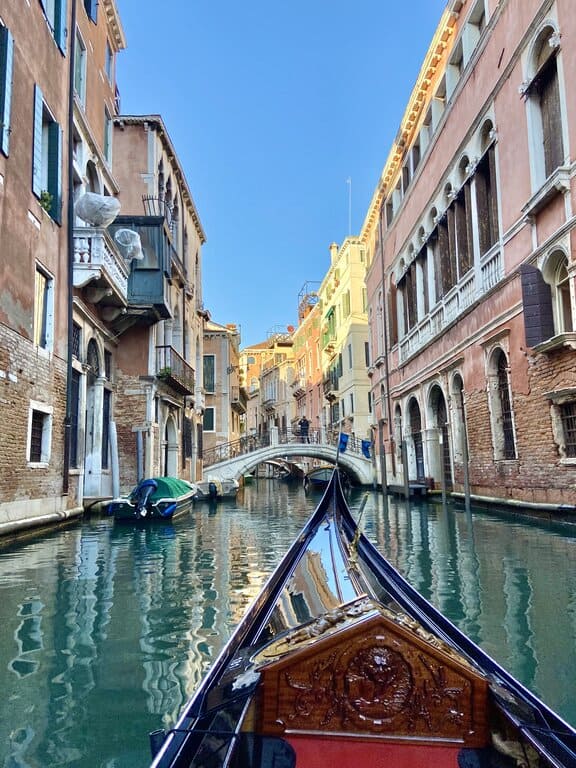

A standard private gondola ride for 2-6 people costs 80 euros during the day and 100 euros at night. They can be booked at one of the many kiosks you see along the canals, through your hotel, or online ahead of time.
If you’re traveling alone, you can purchase a group gondola tour so you’ll have some people to enjoy it with. This option will put you on a boat with random people and costs between 25-35 euros per person depending on the agency offering the tour. Some couples choose to do this as it’s a bit cheaper than a private experience.
Some additional Venice tour options:
Travel insurance
We use World Nomads when we travel to Italy so that we are prepared for the unexpected. Word Nomads provides coverage to travelers in over 100 countries. You can search for a coverage plan using the link below.
How Exactly Was Venice Built?
Because I’m a structural engineer you’re going to get a quick lesson on how this amazing city was built in the middle of a marshy lagoon in the middle ages. Venice is truly one of the most unique cities in the world. It’s a miracle of ancient engineering and it’s important to know what exactly you’re standing on as you wander the ancient walkways.
Wooden piles
The city of Venice consists of 118 islands with 150 man made canals. But the land was just a swamp, incapable of supporting structures. So they had to figure out how to support the weight of heavy masonry buildings. To do this the Venetians drove thousands of timber piles into the soft ground.
The timber piles – just trunks of alder trees with the branches removed – were hammered down through the swampy soils into the firm clay layer of soil well below the surface. As there was no forest nearby, all the wood had to be transported by boat from the southern coast of the Adriatic Sea.
The piles were spaced so tightly together that stones and pebbles could be placed between the piles to prevent the rise of sediment and silt. And because the piles are all completely underwater, they’ve never been exposed to air and never been subject to rotting.
On top of the piles they placed layers of flat wood then masonry foundations. From there the buildings were constructed like any other buildings back in those days. So basically, when you’re walking around Venice, you’re standing on closely spaced tree trunks, some up to 1000 years old, instead of solid land!

OK… but why go through all that trouble?
If it sounds odd that people would build a city on a marshy desolate land where nothing grows, well, they must have felt they didn’t really have a choice. Driven from their homes by waves of Hun and Germanic invasions, they fled to the marshland in the nearby lagoon.
While very few records exist from those days, it’s believed that poor fishermen were already living on the lagoon. As more refugees fled, it became apparent that more infrastructure would have to be constructed and Venice was born.
That’s the cliff notes for you. If I’ve piqued your curiosity I encourage you to read as much as you can about the history and construction of Venice because it’s truly fascinating. Knowing the history and how it was built makes it all the more special to see in person.
Venice in Winter – FAQs
Can you ride a gondola in Venice in winter?
Yes, the gondolas in Venice operate year round. It’s the biggest money making gimmick in the city so you can be sure they keep those things running unless there is inclement weather.
Do the canals in Venice freeze in winter?
While it’s certainly possible for the canals in Venice to freeze in the winter, and it has happened before, it’s extremely rare. It’s highly unlikely that you’ll have subfreezing temperatures for days on end on your winter trip to Venice.
Does Venice shut down for winter?
No, Venice does not shut down for winter. The city remains lively and active throughout the winter, even if there are a fraction of tourists that summer season sees.
Is Venice worth visiting in winter?
Venice is absolutely worth visiting in the winter! There are far fewer tourists descending upon the city in the winter months and the mild temperatures make it relatively comfortable for walking around the city. Everything remains open in the winter and hotel prices are significantly discounted.
Final Word
Visiting Venice in the winter has numerous advantages. If you can manage the weather and shorter days you’ll be rewarded with seeing this magical city without the hordes of tourists that are present in the warmer months.
You’ll also save a lot of money on your accommodation and be able to enjoy the day without wondering if you’ll get a seat at the best restaurants in town. Venice is truly like nothing else in the world and will blow you away. Enjoy!

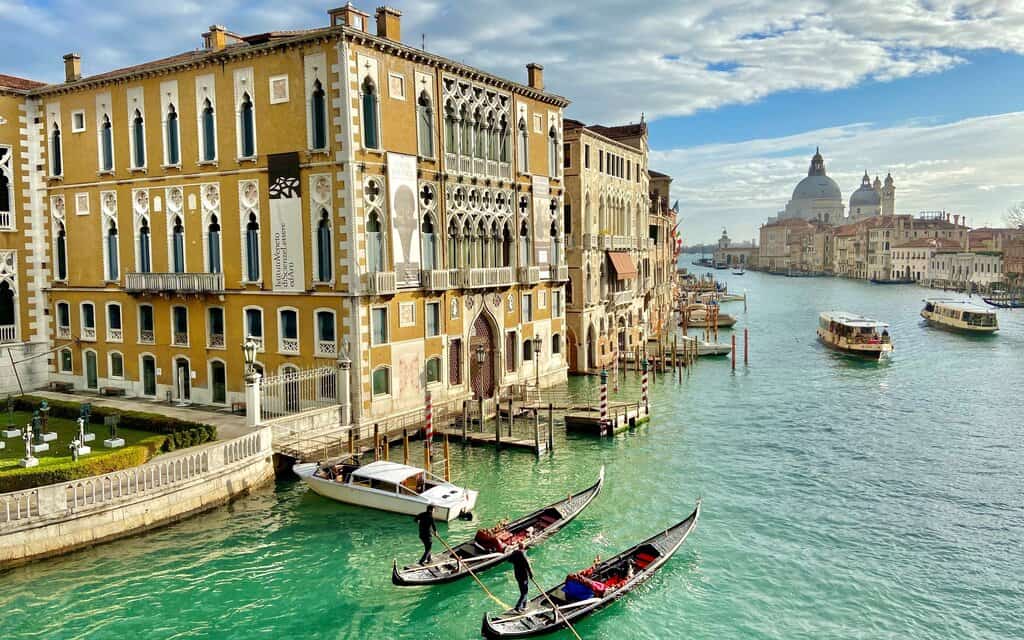
1 comment
[…] a unique charm in the colder months. Learn more about what makes Venice so special in the winter here. This season also brings some unique ingredients and dishes to the forefront of Italian cooking, […]